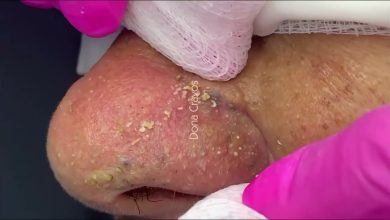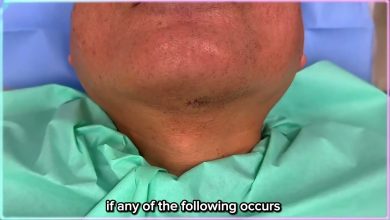Successful Removal of a Large Epidermal Cyst from the Mid-Chest: A Comprehensive Procedure Overview

Epidermal cysts, also known as sebaceous cysts, are non-cancerous, closed pockets of tissue filled with oil, dead skin cells, and other debris. These cysts can appear anywhere on the body, including the face, scalp, back, and chest. While often painless, large epidermal cysts can become unsightly, uncomfortable, and may even pose health risks if left untreated. In this article, we’ll walk through the successful removal of a large epidermal cyst located on the mid-chest, outlining the procedure, recovery, and important considerations.

Understanding Epidermal Cysts
Epidermal cysts are typically caused by the blockage of hair follicles or skin pores. This blockage prevents oil and other substances from draining, causing them to build up underneath the skin, forming a cyst. They can range in size, and when large, they may press on surrounding tissues, causing discomfort or irritation. The cysts may also become infected or inflamed, resulting in pain and other complications.
The Importance of Medical Intervention
While small cysts can sometimes be managed with home remedies or observation, larger cysts or those causing symptoms usually require medical intervention. A large cyst located on the mid-chest can be particularly concerning, as it may cause difficulty with movement, irritation from clothing, or become prone to infection.
In this case, the patient sought professional care after experiencing discomfort due to the size and location of the cyst. After a thorough examination, the decision was made to remove the cyst surgically.
The Surgical Procedure
1. Consultation and Diagnosis
The first step in the process was a detailed consultation with a dermatologist or surgeon. During this visit, the healthcare professional assessed the size, location, and any potential risks associated with the cyst. The patient’s medical history, including any prior skin conditions or reactions to anesthesia, was reviewed to ensure a safe procedure.
The cyst was determined to be large, and the decision was made to remove it entirely rather than opting for drainage or non-invasive treatments. Complete removal helps prevent recurrence, as draining or puncturing the cyst may only temporarily relieve symptoms but leaves behind remnants that could eventually cause the cyst to reform.
2. Anesthesia and Preparation
On the day of the procedure, the patient was prepared in a sterile environment. Local anesthesia was administered to the area surrounding the cyst to ensure the patient’s comfort throughout the procedure. This allowed the surgeon to work on the cyst without causing the patient pain, while they remained awake and alert.
For larger cysts, or those in a more complex location like the chest, general anesthesia might sometimes be considered to ensure complete relaxation and control.
3. Incision and Cyst Removal
Once the area was numbed, a small incision was made over the cyst. The surgeon carefully dissected the tissue to isolate the cyst from the surrounding skin and structures. It is critical to remove the cyst’s entire capsule, as leaving behind even a small portion could cause the cyst to regrow.
In the case of larger cysts, this step can take a bit longer and requires precision to ensure that the removal does not damage surrounding structures such as nerves, blood vessels, or muscle tissue. The cyst was carefully lifted out, and the wound was cleaned thoroughly.
4. Closure and Healing
After the cyst was successfully removed, the incision site was carefully closed using sutures. In some cases, dissolvable stitches may be used, while in others, the stitches may need to be removed after a week or so. A sterile dressing was applied to the area, and the patient was given aftercare instructions.
Post-Surgical Care and Recovery
Following the removal of a large epidermal cyst from the mid-chest, recovery time can vary depending on factors such as the size of the cyst, the complexity of the procedure, and the patient’s overall health. Here’s what patients can generally expect during recovery:
1. Immediate Aftercare
After the procedure, the patient was given a bandage to protect the incision site. It’s important to keep the area clean and dry to prevent infection. The patient was advised to avoid any strenuous activity or heavy lifting, particularly in the first few days, to allow the skin to heal properly.
2. Pain Management
Most patients experience mild discomfort or tenderness in the first few days after surgery. Pain can be managed with over-the-counter medications, and the healthcare provider may prescribe stronger painkillers if necessary. Swelling or bruising around the surgical site is common and usually subsides within a few days.
3. Follow-up Appointments
The patient was scheduled for a follow-up appointment to monitor the healing process. During this visit, the surgeon assessed the surgical site for any signs of infection, unusual swelling, or complications. Stitches, if not dissolvable, were removed at this time.
4. Watch for Signs of Infection
As with any surgical procedure, there is a small risk of infection. The patient was instructed to watch for signs such as increased redness, warmth, or discharge at the incision site. If these symptoms occur, the patient was advised to contact the healthcare provider immediately.
5. Long-Term Care
Once the incision healed, the patient was encouraged to avoid exposing the area to direct sunlight to minimize scarring. Additionally, the healthcare provider may recommend moisturizing the skin around the incision to help with healing.
Benefits of Complete Cyst Removal
The benefits of removing a large epidermal cyst entirely are numerous. First and foremost, it eliminates the risk of recurrence, which is especially important for larger cysts. Secondly, the procedure prevents any potential for the cyst to become infected or cause long-term irritation.
While scarring is a concern with any surgery, the scar left from a well-performed cyst removal is typically minimal and fades over time, particularly with proper aftercare. In many cases, patients are able to resume their normal activities once healing is complete.
Conclusion
The successful removal of a large epidermal cyst from the mid-chest is a straightforward procedure that can significantly improve a patient’s comfort and aesthetic concerns. By choosing professional surgical intervention, patients can avoid complications, ensure complete cyst removal, and prevent recurrence.
If you or someone you know is experiencing discomfort from an epidermal cyst, consult with a dermatologist or surgeon to explore your treatment options. With proper care and expert surgical removal, relief is just a procedure away.





